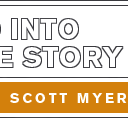At Ryan's encouragement, I went ahead and watched the movie, after reading the script. I'm glad I did. It's an entertaining movie with a lot going on in it. It also aligns nicely with my obsession with character-driven storytelling because Stan's inner nature propels everything about the story including the cast of characters.
For over two decades, I have been drawn to analyzing movies and TV series through the lens of five primary character archetypes: Protagonist, Nemesis, Attractor, Mentor, Trickster. In fact, Part II of my book The Protagonist's Journey is dedicated to an immersion in what I call the Family of Characters, the interrelationship of each of these archetypes in multiple movies and television series.
Reminder: Character archtypes are tools, not rules. Use them and if they help you as a writer, great. If not, don't.
As far as Nightmare Alley is concerned, here is a take on the story's character archetypes.
Protagonist: Stan. No question about that as he is the story's central character, the narrative follows his physical and psychological journey, his character is the one who goes through the most substantive psychological change, the story is told through his perspective, and so forth.
Nemesis: I'm going to use the Jungian concept of the Shadow. For Stan, that is a set of dark instincts related to his father and the impact of his father upon Stan's own psyche.
--Stan hates his father. His father was an alcoholic until Stan turned ten. Although unspoken, it is likely his father was abusive toward Stan (this is suggested obliquely when Lilith interrogates Stan about the relationship he had with his father).
--Stan killed his father by freezing him to death, so there's that reality roiling around inside Stan's psyche.
--Stan blames his father for his mother leaving the family to chase after her lover, a vaudeville act. Stan tells Lilith (paraphrasing), "My father was too weak to keep my mother from leaving."
--But here is probably the biggest thing: Because Stan never felt loved by his father, he (Stan) probably has a really primal, infantile sense of shame that he did not, maybe even does not deserve to be loved. This fuels almost every bad choice Stan makes as he pursues financial and career success. Why? In order to prove to his father, "I am worthy. I am worth it. I deserve love."
Sure, Stan does everything he can to distance himself from his father ("I'll never be like him"). but by being motivated to create that distance, this proves he is not clear of his father, in fact, the very fact he actively attempts to create a sense of space and separation from his father proves he is still connected to and influenced by his father.
That sense of feeling unloved and unlovable is rounded out beautifully in the movie as in the Denouement, Stan will take on the role of the "geek." Laughing, his final words are, "I was born for it." It suggests the father treated Stan like a "geek." Yet another aspect of Stan's shadow which, as I suggest, functions as a Nemesis dynamic.
Attractor: This is typically a character who is most connected to the Protagonist's emotional development. In this regard, Molly is a True Attractor and - at time - Lilith dons the mask of False Attractor. If there is a chance for Stan to opt for a more authentic path in life, one not dominated and influence by the Parent Path (in Stan's case, attempting to separate himself from his Father's influence), it is with Molly. In the end, Stan turns away from that, caught up in Lilith's influence and Stan's ongoing attempts to distance himself from his Father.
Mentor: Clem and Pete provide wisdom, such as it is, in Act One when Stan lives at the carny, Clem with carny life in general; Pete with the mind-reading act. Once Stan goes off on his own, Lilith dons a Mentor mask when she plays the role of psychiatrist.
Trickster: This is probably the most accurate take on Lilith's character who at times is an ally in Stan's plan, but also enemy as capped off by their final scene together. In fact, her whole femme fatale persona fits into the Trickster mode.
Each of these key characters serves and supports Stan's psychological journey, one of dissolution as he is engulfed by his shadow.
Next: Themes.
